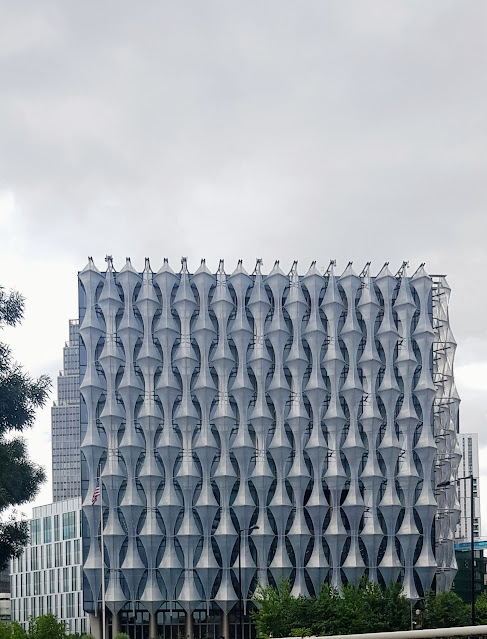 |
| 33 Nine Elms Lane, London, SW11 7US. |
Compared to the old embassy building in Grosvenor Square, I find this new building rather boring. Designed as a cube, this block, which is the largest American embassy in Western Europe, has a semi-circular pond, public green spaces and entry pavilions within its grounds.
 |
| The north side of the embassy, as seen from the River Thames. |
The lightweight 'sails', that adorn three sides of the building, stop direct sunlight hitting the interior and also make the building less likely to bird strikes.
 |
| Here you can see the sunlight being diffused by the outer structure. |
This design, however, does make for some great photo opportunities.
Brief History
Throughout the 1980s and 1990s security, at the London Chancery Building in Grosvenor Square, was tightened following worldwide terrorist attacks on U.S. embassies and consulates.
Following the World Trade Centre attack, on September 11, 2001, security operations saw armed roadblocks outside the Embassy and one side of Grosvenor Square closed to public access by car.
 |
| The west side of the building. |
In 2007 the U.S. embassy made an unsuccessful bid to purchase Chelsea Barracks, to be used as their new Embassy building in England.
In 2008 the U.S. embassy agreed to purchase land in the Vauxhall/Nine Elms/Battersea area, south of the River Thames.
In 2009 the U.S. government sold the lease of the Chancery Building Grosvenor Square to Qatari Diar, a Qatari real-estate firm.
In 2010 the U.S. government announced that the Kieran Timberlake firm had won the design competition. (By law, the architect for a U.S. embassy must be an American firm with "numerous security clearances").
In 2013 ground was broken on the site in Nine Elms.
In 2017 the building opened to the public.
 |
| The west and south sides. |
The Embassy Buildings - A Sustainable Site.
The first American legation in London opened in 1785, when John Adams was appointed the first minister.
Below is a list of the locations of the U.S. embassy, throughout the centuries in London.
- Great Cumberland Place
- Piccadilly
- 98 Portland Place (1863–1866)
- 123 Victoria Street in Westminster (1883–1893) (1893–1912)
- 4 Grosvenor Gardens (1912–1938)
- 1 Grosvenor Square (1938–1960)
- London Chancery Building in Grosvenor Square (1960–2018)
- 33 Nine Elms Lane, (2018-)
Very good history. Having seen the building myself from the outside, I was rather unimpressed. It looks like it's clad in plastic and, for me, doesn't win any prizes.
ReplyDeleteThe building definitely looks like an art project that hasn't quite worked.
ReplyDelete